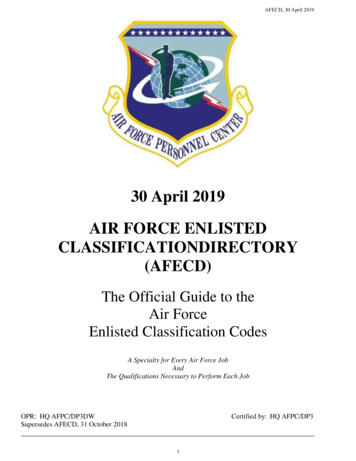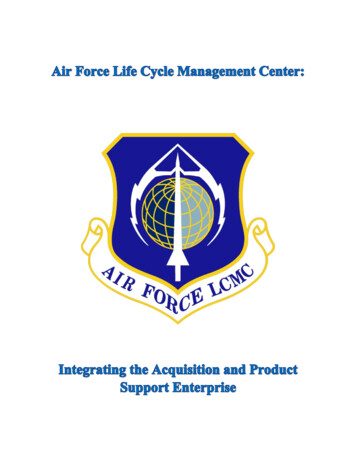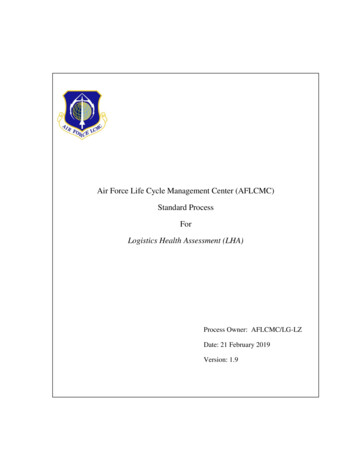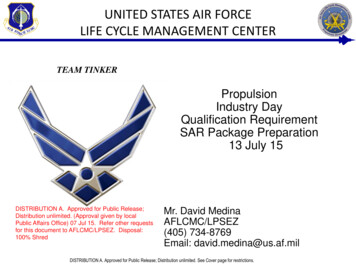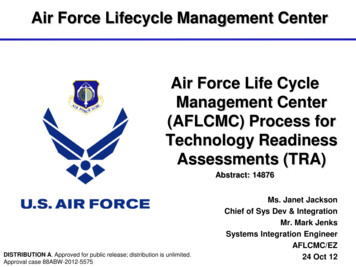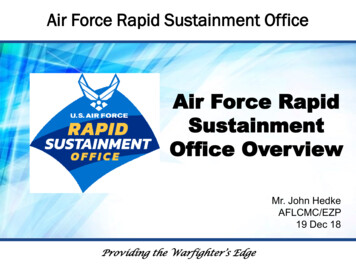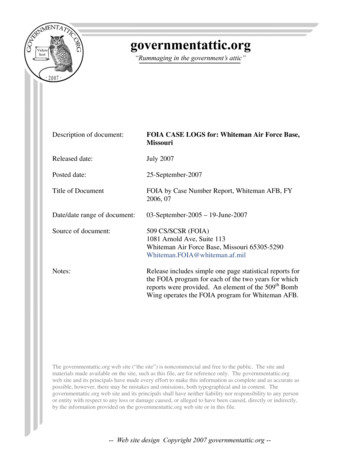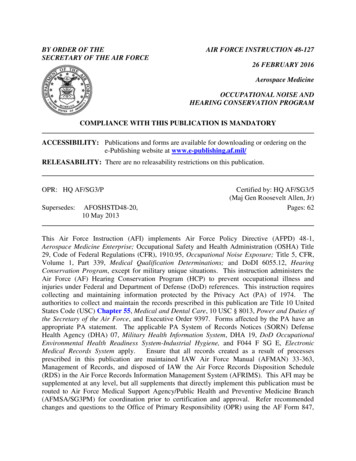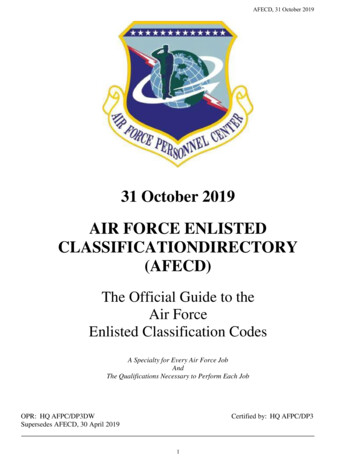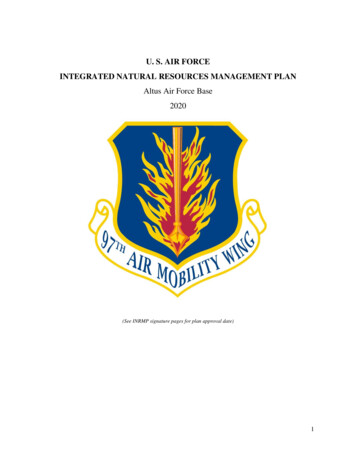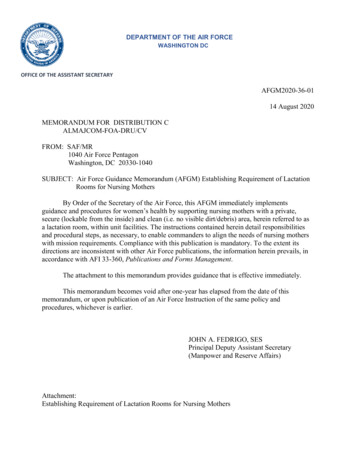
Transcription
DEPARTMENT OF THE AIR FORCEWASHINGTON DCOFFICE OF THE ASSISTANT SECRETARYAFGM2020-36-0114 August 2020MEMORANDUM FOR DISTRIBUTION CALMAJCOM-FOA-DRU/CVFROM: SAF/MR1040 Air Force PentagonWashington, DC 20330-1040SUBJECT: Air Force Guidance Memorandum (AFGM) Establishing Requirement of LactationRooms for Nursing MothersBy Order of the Secretary of the Air Force, this AFGM immediately implementsguidance and procedures for women’s health by supporting nursing mothers with a private,secure (lockable from the inside) and clean (i.e. no visible dirt/debris) area, herein referred to asa lactation room, within unit facilities. The instructions contained herein detail responsibilitiesand procedural steps, as necessary, to enable commanders to align the needs of nursing motherswith mission requirements. Compliance with this publication is mandatory. To the extent itsdirections are inconsistent with other Air Force publications, the information herein prevails, inaccordance with AFI 33-360, Publications and Forms Management.The attachment to this memorandum provides guidance that is effective immediately.This memorandum becomes void after one-year has elapsed from the date of thismemorandum, or upon publication of an Air Force Instruction of the same policy andprocedures, whichever is earlier.JOHN A. FEDRIGO, SESPrincipal Deputy Assistant Secretary(Manpower and Reserve Affairs)Attachment:Establishing Requirement of Lactation Rooms for Nursing Mothers
1. Overview: The guidance contained herein details procedures for commanders to supportnursing mothers with a lactation room to nurse or express milk in close proximity of a nursingmother’s workplace within unit facilities under the control of a unit commander or equivalent.1.1. It provides roles, responsibilities, and requirements and applies to all Regular Air Force, AirNational Guard, and Air Force Reserve units who have Service members or civilian employeesthat are nursing mothers.1.2. The requirement for all elements of the Executive Branch to implement policies andprocedures for lactation rooms stems from Public Law (PL) 111-148, Patient Protection andAffordable Care Act, §4207. Following passage of this Act, the President of the United Statesdelegated authority to the Office of Personnel Management (OPM) to regulate implementationthroughout the Executive Branch. OPM subsequently issued a Nursing Mothers in FederalEmployment memorandum for heads of Executive departments and agencies, and Guide forEstablishing a Federal Nursing Mother’s Program. Department of Defense (DoD) policy wasthen set out in the memorandum, Department-Wide Policy for Nursing and Lactation Rooms.Providing nursing mothers with a private space was further codified in (DOD) Unified FacilitiesCriteria (UFC) 1-200-01, DoD Building Code (General Building Requirements), Chapter 3,paragraph 3-2.2.2. Air Force Policy: It is Air Force policy to remain committed to women’s health as a corecomponent of a lethal, ready force and will provide a lactation room in accordance withprocedures shown in paragraph 3 below for Service member and civilian employee mothers whochoose to breastfeed upon return to duty or work, respectively, following pregnancies. Theprocedures to implement a lactation room balance the mission readiness needs of units whileaffording nursing mothers the opportunity to continue breastfeeding, pursuant to the UnitedStates Surgeon General’s goals for increasing breastfeeding for a period of a minimum of oneyear after a child’s birth.3. Procedures:3.1. Unit Commanders will:3.1.1. Identify a private, secure (lockable from the inside) and clean area as a lactation room inthe immediate vicinity of unit facilities or temporary work-station that is available to meet theneeds of breastfeeding Service members and civilian employees to breastfeed or express breastmilk. (T-0). This room can be temporary, depending on the unit’s circumstances and Servicemember/civilian employee needs. Temporary or flexible space can be available offices,conference rooms, break rooms or other rooms which meet criteria below. If a lactation room isconfigured for multiple users, the room will be configured so each user has privacy. (T-0).When establishing the location of the lactation room, consideration will be given to the limitedamount of time Service members and civilian employees may have for breaks. Units in closeproximity to each other (within the same building complex or in buildings that have entranceswithin 100 feet) may choose to share lactation rooms. The time needed for nursing mothers willvary per individual and also includes concepts that nursing mothers should be relaxed, wellhydrated, and in a space with comfortable temperatures and adequate lighting.3.1.1.1. Lactation rooms must be clean and free of any visible dirt/debris. (T-0). Do not use
restrooms, to include shower rooms and locker rooms. (T-0).3.1.1.2. Ensure the units with industrial work settings identify and maintain lactation roomconsistent with direction for break rooms per Air Force Manual 91-203, Air Force OccupationalSafety, Fire, and Health Standards. (T-1).3.1.1.2.1. Lactation rooms will not contain toxic materials, chemicals, or industrial shopcontaminants. (T-0).3.1.1.2.2. Personnel using a lactation room will adhere to the same industrial hygiene practicesas a break room, removing personal protective equipment, changing clothes when contaminatedwith solvents, lubricants or fuels prior to entry and washing their hands prior to using thelactation room. (T-3).3.1.1.2.3. Installation Public Health shall periodically inspect the lactation rooms in theindustrial work unit in the same manner as break rooms. (T-1).3.1.1.3. The lactation room will be near a source of hot and cold water for hand washing/breastpump cleaning and contain multiple electrical outlets within the room for use of breast pumps.(T-0). It must contain a trash can, paper towels and cleaning supplies made available by the unit.(T-0).3.1.1.4. The lactation room must have comfortable seating and a table or similar flat surface,other than the floor, to place the breast pump and other supplies. (T-0). The room must haveadequate temperature control, adjustable lighting, and clothing hooks. (T-0).3.1.2. Ensure supervisors provide Service members and civilian employees’ time to utilize thelactation room while balancing mission work schedules. (T-0) Commanders and supervisorswill provide Service members and civilian employees with reasonable lactation breaks to allowadequate time for expression transport to storage location. (T-0). The duration of the lactationbreak varies, including the time to express breast milk (which depends on the age of the infant,the amount of milk produced, a stress free environment, quality of pump, etc.) as well as thedistance the lactation room is from the work area, the convenience of water and refrigerationsources and cleaning supplies.3.1.3. Establish organizational rules and procedures for scheduling and/or utilization, to includemaintenance and cleaning, of the lactation room for nursing mothers. (T-3).3.1.4. If the requirements of field training and exercises permit, commanders should ensureService members and civilian employees have a clean, private space, specifically not a restroomor latrine, in which to pump breast milk. (T-1). With the consent of all lactation room users andprovided adequate space exists, more than one nursing mother may utilize the lactation room atone time.3.1.5. Consult with:3.1.5.1. Appropriate installation civilian personnel offices for appropriated/non-appropriatedfund employees to determine break time entitlements for nursing mother practices. (T-1).
3.1.5.2. The Base Civil Engineer to establish lactation rooms, based on need, pursuant toDepartment of Defense (DoD) Unified Facilities Criteria (UFC) 1-200-01, paragraph 3-2.2. (T3). All work that modifies the facility should be coordinated with installation Civil EngineerSquadron or equivalent organization.3.1.5.3. Installation medical services for information on nursing mother issues, cleaningrequirements, or any other associated medical issues that may arise when establishing ormaintaining a lactation room. (T-3).3.2. In addition to 3.1., commanders must provide refrigeration and freezer storage units forexpressed human breast milk for personnel TDY at the installation. (T-1).3.2.1. If the requirements of field training and exercises permit, commanders should work withthe supporting medical officer to determine whether milk storage or transportation will befeasible. If the Airman cannot transport expressed milk to their home station, the commanderwill permit her the same time and space to express and discard her breast milk with the intent tomaintain physiological capability for lactation. Commanders will work with the supportingmedical officer to counsel Airmen and discuss the potential risks of storing milk during fieldtraining and mobility exercises. (T-1).3.2.1.1. Service members/civilian employees must comply with the following when storingexpressed human breast milk in a food refrigerator or freezer (e.g., any unit used in whole or partto store human food and beverage):3.2.1.2. Place in sealable separate package (bag, bottle) contained inside a larger, clean, covered,leak-proof container labeled with the individual’s name, unit, contact information, and date ofmilk expression. (T-1).3.2.1.3. Breast milk should be contained and labeled by the Service member/civilian employeeto avoid contamination by other items located in the vicinity. Information regarding breast milkstorage is available on the CDC Breastfeeding Web page s/handling breastmilk.htm3.2.1.4. Storage of expressed milk is contingent on storage space availability within thedesignated refrigeration or freezer storage units. Notify the responsible unit commander todetermine alternate location if there is no room within the storage unit.3.2.2. Discard refrigerated expressed breast milk not retrieved by the Airman after four daysfrom the recorded date of expression. (T-1). Discard frozen expressed breast milk not retrievedby the Airman after four months from the recorded date of expression. (T-1). Discard expressedhuman breast milk immediately if not properly packaged, labeled, and dated in accordance withparagraph 3.2.1.1. (T-1).3.2.3. Handle expressed breast milk according to the local policy for other food items during arefrigerator/freezer failure. (T-1). Make every effort to contact the nursing mother and obtainher decision on disposition. (T-1).3.2.4. Recommended locations to store expressed breast milk include, such as but not limited to,lactation room refrigerators, lodging refrigerators, schoolhouse refrigerators, field kitchens, etc.(T-1).
3.2.4.1. Local dining facilities generally are not the preferred storage location; however, they arenot excluded as a potential local storage location. Installations must assess the readiness of thedining facility to store expressed breast milk. (T-1). If no other installation storage facilitycapabilities are available, installations should be prepared to allow access to local diningfacilities.3.2.5. The time nursing mother’s need to pump or express breast milk should include additionaltime, if needed, transport milk to the storage location.3.3. Service member/civilian employee nursing mothers must provide their own breast pumpequipment and hygiene cleaning materials. (T-0).References1. PL 111-148, Patient Protection and Affordable Care Act, 23 March 20102. OPM Memorandum for Heads of Executive Departments and Agencies, Nursing Mothersin Federal Employment, 22 December 20103. OPM Guide for Establishing a Federal Nursing Mother’s Program, January 20134. Under Secretary of Defense for Personnel and Readiness Memorandum, DepartmentWide Policy for Nursing and Lactation Rooms, 1 Nov 20165. DoD Unified Facilities Criteria (UFC) 1-200-01, DoD Building Code (General BuildingRequirements), Change 2, 1 November 20186. Air Force Manual 91-203, Air Force Occupational Safety, Fire, and Health Standards,11 December 2018Abbreviations and AcronymsDoD—Department of DefenseOPM—Office of Personnel ManagementPL—Public lawUFC—Unified Facility Criteria
Aug 14, 2020 · 2. OPM Memorandum for Heads of Executive Departments and Agencies, Nursing Mothers in Federal Employment, 22 December 2010 3. OPM Guide for Establishing a Federal Nursing Mother’s Program, January 2013 4. Under Secretary of Defense for Personnel and Readiness Memorandum, Department-Wide Policy for


